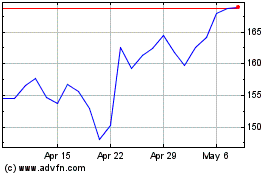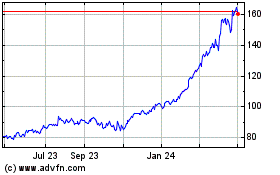GE Pitches Investors on Its Health-Care Unit, a Steady Source of Cash
December 01 2019 - 8:29AM
Dow Jones News
By Thomas Gryta
General Electric Co. aims to excite investors about its
health-care division, a business that was tagged to be cast off but
is now central to the company's turnaround efforts.
GE Healthcare, which is based in Chicago and employs more than
50,000 people, makes magnetic resonance imaging machines and other
hospital equipment. At the depths of its crisis, GE set plans to
spin off the unit. Now, Chief Executive Larry Culp refers to it as
one of the conglomerate's pillars.
The division, with $20 billion in annual revenue, has been a
cash cow for the troubled company: GE Healthcare accounted for 16%
of GE's total revenue last year but 36% of its operating profit,
according to data from S&P Global Market Intelligence.
But it is about to shrink. Soon after taking over, just over a
year ago, Mr. Culp struck a deal to sell a part of the division
that serves the biotechnology industry. The sale will raise $21
billion to help pay down GE's debt but leaves GE Healthcare without
its fastest-growing businesses.
For many investors, the health-care business has been on the
periphery for the past two years as they focused on the problems in
GE's power and financial-services divisions. To get them
enthusiastic about it, GE Healthcare is holding an investor meeting
with the division's management on Monday.
"The perception is that the remaining health-care business,
which is very large, is slow growth," said Nigel Coe, analyst at
Wolfe Research, who will be listening for details on how the health
division plans to increase sales, market share and profit
margins.
Former GE CEO John Flannery ran the health business before being
named to the top job in mid-2017. Problems at the conglomerate came
to light during his tenure as CEO, leading to aggressive
restructuring and his eventual replacement with Mr. Culp.
Mr. Flannery planned an initial public offering for the health
division, part of a plan to focus on the power and aviation
divisions. It was a course Mr. Culp supported until he cut a deal
in February 2019 to sell the life-sciences part of the health
business to his former company, Danaher Corp. Analysts expect GE
Healthcare to stay inside GE while management works to improve its
results; Mr. Culp has said GE has "optionality" for its future.
Life sciences, also called biopharma, sells equipment used in
the biotechnology industry, which makes drugs composed of proteins
made in living cells using a complex production process. The unit
also makes imaging agents used in medical scans to highlight
specific organs or functions. It accounted for about $4 billion in
revenue last year.
The remaining GE Healthcare, expected to be the focus of
Monday's meeting, is the more industrial side and traces its roots
back more than a century when it began developing X-rays. It
manufactures MRI machines, computed tomography scanners, X-ray
systems and ultrasound devices. It also services equipment and
sells related software.
That area of the business has slower growth but isn't prone to
cyclical forces like other parts of GE, analysts said, something
that could help the company as it continues to stabilize its
finances.
"The business overall is solid but not exceptional," said Melius
Research analyst Scott Davis. He called the division reasonably
profitable and said there is plenty of room for Mr. Culp to improve
sales growth and margins.
Morgan Stanley analysts project 2019 operating profit margins of
19.3% for GE Healthcare, but executives are expected to give
details Monday on what that profitability will be after it sells
the life-sciences business.
"The near- and medium-term opportunities we see to drive cash
flow growth and improve operating margins in Healthcare are an
important component of the value GE can create for our stakeholders
over time," a GE spokeswoman said.
German rival Siemens AG has spun off its health business into a
separate company, called Siemens Healthineers AG, that is 85% owned
by the parent. The spinoff's shares are up 20% so far this year,
which is similar to its parent's performance.
Siemens, which once sold everything from mobile phones to
lightbulbs, has shed the conglomerate model under CEO Joe Kaeser
and focused on its higher-growth divisions. It plans to spin off
its power business next year, after merging it with its
renewable-energy business.
GE has also streamlined its structure after cash-flow woes
forced the company to twice slash its dividend, leaving it at just
a penny per share. It merged its oil and gas business into Baker
Hughes in 2017 and took a roughly two-thirds stake, but has
recently sold its holdings to less than 40%. GE has also sold off
its stake in Wabtec Crop. after merging its transportation business
with the railroad supplier. GE expects to close the life-sciences
sale to Danaher in early 2020.
After tumbling from $30 to below $10, GE shares have rallied
more than 50% this year to close Friday above $11. The stock has
advanced as Mr. Culp made progress on efforts to pay down debts and
generate cash from the industrial operations.
Write to Thomas Gryta at thomas.gryta@wsj.com
(END) Dow Jones Newswires
December 01, 2019 08:14 ET (13:14 GMT)
Copyright (c) 2019 Dow Jones & Company, Inc.
GE Aerospace (NYSE:GE)
Historical Stock Chart
From Mar 2024 to Apr 2024

GE Aerospace (NYSE:GE)
Historical Stock Chart
From Apr 2023 to Apr 2024
